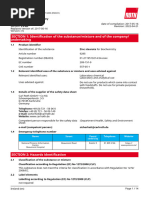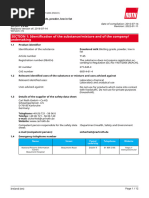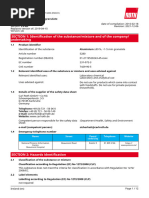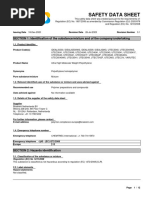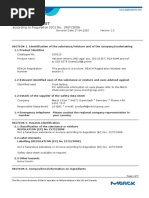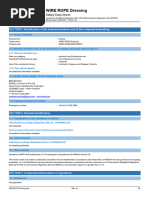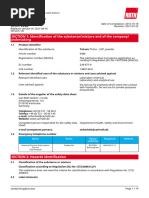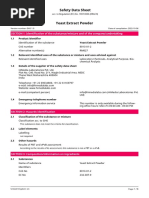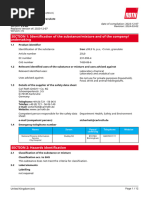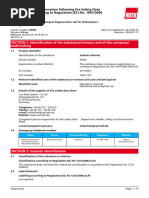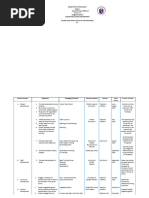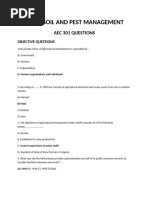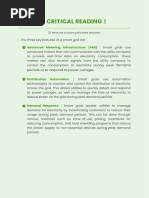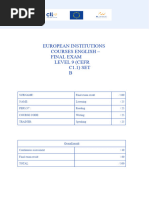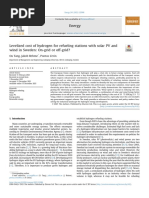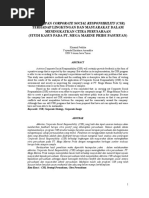SDB 0987 Ie en
SDB 0987 Ie en
Uploaded by
Iharena MorasataCopyright:
Available Formats
SDB 0987 Ie en
SDB 0987 Ie en
Uploaded by
Iharena MorasataOriginal Title
Copyright
Available Formats
Share this document
Did you find this document useful?
Is this content inappropriate?
Copyright:
Available Formats
SDB 0987 Ie en
SDB 0987 Ie en
Uploaded by
Iharena MorasataCopyright:
Available Formats
Safety data sheet
according to Regulation (EC) No. 1907/2006 (REACH)
Roti®-PreMIX PBST 7.4 for biochemistry, for molecular biology
article number: 0987 date of compilation: 2017-08-03
Version: 2.0 en Revision: 2022-04-27
Replaces version of: 2017-08-03
Version: (1)
SECTION 1: Identification of the substance/mixture and of the company/
undertaking
1.1 Product identifier
Identification of the substance Roti®-PreMIX PBST 7.4 for biochemistry, for mo-
lecular biology
Article number 0987
Registration number (REACH) not relevant (mixture)
1.2 Relevant identified uses of the substance or mixture and uses advised against
Relevant identified uses: Laboratory chemical
Laboratory and analytical use
Uses advised against: Do not use for products which come into contact
with foodstuffs. Do not use for private purposes
(household).
1.3 Details of the supplier of the safety data sheet
Carl Roth GmbH + Co KG
Schoemperlenstr. 3-5
D-76185 Karlsruhe
Germany
Telephone:+49 (0) 721 - 56 06 0
Telefax: +49 (0) 721 - 56 06 149
e-mail: sicherheit@carlroth.de
Website: www.carlroth.de
Competent person responsible for the safety data :Department Health, Safety and Environment
sheet:
e-mail (competent person): sicherheit@carlroth.de
1.4 Emergency telephone number
Name Street Postal Telephone Website
code/city
National Poisons Information Beaumont Road Dublin 9 01 809 2166 https://
Centre www.poisons.ie/
Beaumont Hospital
SECTION 2: Hazards identification
2.1 Classification of the substance or mixture
Classification according to Regulation (EC) No 1272/2008 (CLP)
This mixture does not meet the criteria for classification in accordance with Regulation No 1272/2008/
EC.
2.2 Label elements
Labelling according to Regulation (EC) No 1272/2008 (CLP)
not required
Ireland (en) Page 1 / 12
Safety data sheet
according to Regulation (EC) No. 1907/2006 (REACH)
Roti®-PreMIX PBST 7.4 for biochemistry, for molecular biology
article number: 0987
2.3 Other hazards
Results of PBT and vPvB assessment
This mixture does not contain any substances that are assessed to be a PBT or a vPvB.
SECTION 3: Composition/information on ingredients
3.1 Substances
not relevant (mixture)
3.2 Mixtures
Description of the mixture
This product does not meet the criteria for classification in any hazard class according to GHS
SECTION 4: First aid measures
4.1 Description of first aid measures
General notes
Take off contaminated clothing.
Following inhalation
Provide fresh air.
Following skin contact
Rinse skin with water/shower.
Following eye contact
Rinse cautiously with water for several minutes.
Following ingestion
Rinse mouth. Call a doctor if you feel unwell.
4.2 Most important symptoms and effects, both acute and delayed
Symptoms and effects are not known to date.
4.3 Indication of any immediate medical attention and special treatment needed
none
SECTION 5: Firefighting measures
5.1 Extinguishing media
Suitable extinguishing media
co-ordinate firefighting measures to the fire surroundings
water, foam, dry extinguishing powder, ABC-powder
Ireland (en) Page 2 / 12
Safety data sheet
according to Regulation (EC) No. 1907/2006 (REACH)
Roti®-PreMIX PBST 7.4 for biochemistry, for molecular biology
article number: 0987
Unsuitable extinguishing media
water jet
5.2 Special hazards arising from the substance or mixture
None.
5.3 Advice for firefighters
In case of fire and/or explosion do not breathe fumes. Fight fire with normal precautions from a reas-
onable distance. Wear self-contained breathing apparatus.
SECTION 6: Accidental release measures
6.1 Personal precautions, protective equipment and emergency procedures
For non-emergency personnel
Control of dust.
6.2 Environmental precautions
Keep away from drains, surface and ground water.
6.3 Methods and material for containment and cleaning up
Advice on how to contain a spill
Covering of drains. Take up mechanically.
Advice on how to clean up a spill
Take up mechanically.
Other information relating to spills and releases
Place in appropriate containers for disposal.
6.4 Reference to other sections
Hazardous combustion products: see section 5. Personal protective equipment: see section 8. Incom-
patible materials: see section 10. Disposal considerations: see section 13.
SECTION 7: Handling and storage
7.1 Precautions for safe handling
No special measures are necessary.
Advice on general occupational hygiene
Keep away from food, drink and animal feedingstuffs.
7.2 Conditions for safe storage, including any incompatibilities
Store in a dry place.
Incompatible substances or mixtures
Observe hints for combined storage.
Consideration of other advice:
Ventilation requirements
Use local and general ventilation.
Ireland (en) Page 3 / 12
Safety data sheet
according to Regulation (EC) No. 1907/2006 (REACH)
Roti®-PreMIX PBST 7.4 for biochemistry, for molecular biology
article number: 0987
Specific designs for storage rooms or vessels
Recommended storage temperature: 15 – 25 °C
7.3 Specific end use(s)
No information available.
SECTION 8: Exposure controls/personal protection
8.1 Control parameters
National limit values
Occupational exposure limit values (Workplace Exposure Limits)
Coun Name of agent CAS No Identifi- TWA STEL Ceil- Nota- Source
try er [mg/ [mg/ ing-C tion
m³] m³] [mg/
m³]
IE dusts non-specific OELV 10 i S.I. No. 619
of 2001
IE dusts non-specific OELV 4 r S.I. No. 619
of 2001
Notation
Ceiling-C Ceiling value is a limit value above which exposure should not occur
i Inhalable fraction
r Respirable fraction
STEL Short-term exposure limit: a limit value above which exposure should not occur and which is related to a 15-
minute period (unless otherwise specified)
TWA Time-weighted average (long-term exposure limit): measured or calculated in relation to a reference period of 8
hours time-weighted average (unless otherwise specified)
8.2 Exposure controls
Individual protection measures (personal protective equipment)
Eye/face protection
Use safety goggle with side protection.
Skin protection
• hand protection
Wear suitable gloves. Chemical protection gloves are suitable, which are tested according to EN 374.
• type of material
NBR (Nitrile rubber)
• material thickness
>0,11 mm
• breakthrough times of the glove material
>480 minutes (permeation: level 6)
Ireland (en) Page 4 / 12
Safety data sheet
according to Regulation (EC) No. 1907/2006 (REACH)
Roti®-PreMIX PBST 7.4 for biochemistry, for molecular biology
article number: 0987
• other protection measures
Take recovery periods for skin regeneration. Preventive skin protection (barrier creams/ointments) is
recommended.
Respiratory protection
Respiratory protection necessary at: Dust formation. Particulate filter device (EN 143). P1 (filters at
least 80 % of airborne particles, colour code: White).
Environmental exposure controls
Keep away from drains, surface and ground water.
SECTION 9: Physical and chemical properties
9.1 Information on basic physical and chemical properties
Physical state solid
Form powder, crystalline
Colour white
Odour odourless
Melting point/freezing point not determined
Boiling point or initial boiling point and boiling not determined
range
Flammability non-combustible
Lower and upper explosion limit not determined
Flash point not applicable
Auto-ignition temperature not determined
Decomposition temperature not relevant
pH (value) 7,2 – 7,6 (in aqueous solution: 10,05 g/l, 20 °C)
Kinematic viscosity not relevant
Solubility(ies)
Water solubility not determined
Partition coefficient
Partition coefficient n-octanol/water (log value): this information is not available
Vapour pressure not determined
Density and/or relative density
Density not determined
Relative vapour density information on this property is not available
Ireland (en) Page 5 / 12
Safety data sheet
according to Regulation (EC) No. 1907/2006 (REACH)
Roti®-PreMIX PBST 7.4 for biochemistry, for molecular biology
article number: 0987
Particle characteristics No data available.
Other safety parameters
Oxidising properties none
9.2 Other information
Information with regard to physical hazard hazard classes acc. to GHS
classes: (physical hazards): not relevant
Other safety characteristics: There is no additional information.
SECTION 10: Stability and reactivity
10.1 Reactivity
This material is not reactive under normal ambient conditions.
10.2 Chemical stability
The material is stable under normal ambient and anticipated storage and handling conditions of tem-
perature and pressure.
10.3 Possibility of hazardous reactions
Violent reaction with: strong oxidiser
10.4 Conditions to avoid
There are no specific conditions known which have to be avoided.
10.5 Incompatible materials
There is no additional information.
10.6 Hazardous decomposition products
Hazardous combustion products: see section 5.
SECTION 11: Toxicological information
11.1 Information on hazard classes as defined in Regulation (EC) No 1272/2008
Test data are not available for the complete mixture.
Classification procedure
The method for classification of the mixture is based on ingredients of the mixture (additivity
formula).
Classification according to GHS (1272/2008/EC, CLP)
This mixture does not meet the criteria for classification in accordance with Regulation No 1272/2008/
EC.
Acute toxicity
Shall not be classified as acutely toxic.
Skin corrosion/irritation
Shall not be classified as corrosive/irritant to skin.
Serious eye damage/eye irritation
Shall not be classified as seriously damaging to the eye or eye irritant.
Ireland (en) Page 6 / 12
Safety data sheet
according to Regulation (EC) No. 1907/2006 (REACH)
Roti®-PreMIX PBST 7.4 for biochemistry, for molecular biology
article number: 0987
Respiratory or skin sensitisation
Shall not be classified as a respiratory or skin sensitiser.
Germ cell mutagenicity
Shall not be classified as germ cell mutagenic.
Carcinogenicity
Shall not be classified as carcinogenic.
Reproductive toxicity
Shall not be classified as a reproductive toxicant.
Specific target organ toxicity - single exposure
Shall not be classified as a specific target organ toxicant (single exposure).
Specific target organ toxicity - repeated exposure
Shall not be classified as a specific target organ toxicant (repeated exposure).
Aspiration hazard
Shall not be classified as presenting an aspiration hazard.
Symptoms related to the physical, chemical and toxicological characteristics
• If swallowed
Data are not available.
• If in eyes
Data are not available.
• If inhaled
Data are not available.
• If on skin
Data are not available.
• Other information
Health effects are not known.
11.2 Endocrine disrupting properties
None of the ingredients are listed.
11.3 Information on other hazards
There is no additional information.
SECTION 12: Ecological information
12.1 Toxicity
Shall not be classified as hazardous to the aquatic environment.
.
Biodegradation
Data are not available.
12.2 Process of degradability
Data are not available.
12.3 Bioaccumulative potential
Data are not available.
Ireland (en) Page 7 / 12
Safety data sheet
according to Regulation (EC) No. 1907/2006 (REACH)
Roti®-PreMIX PBST 7.4 for biochemistry, for molecular biology
article number: 0987
12.4 Mobility in soil
Data are not available.
12.5 Results of PBT and vPvB assessment
Data are not available.
12.6 Endocrine disrupting properties
None of the ingredients are listed.
12.7 Other adverse effects
Data are not available.
SECTION 13: Disposal considerations
13.1 Waste treatment methods
Consult the appropriate local waste disposal expert about waste disposal.
Sewage disposal-relevant information
Do not empty into drains.
13.2 Relevant provisions relating to waste
The allocation of waste identity numbers/waste descriptions must be carried out according to the
EEC, specific to the industry and process. Waste catalogue ordinance (Germany).
13.3 Remarks
Waste shall be separated into the categories that can be handled separately by the local or national
waste management facilities. Please consider the relevant national or regional provisions.
SECTION 14: Transport information
14.1 UN number or ID number not subject to transport regulations
14.2 UN proper shipping name not assigned
14.3 Transport hazard class(es) none
14.4 Packing group not assigned
14.5 Environmental hazards non-environmentally hazardous acc. to the dan-
gerous goods regulations
14.6 Special precautions for user
There is no additional information.
14.7 Maritime transport in bulk according to IMO instruments
The cargo is not intended to be carried in bulk.
14.8 Information for each of the UN Model Regulations
Transport of dangerous goods by road, rail and inland waterway (ADR/RID/ADN) - Additional
information
Not subject to ADR, RID and ADN.
International Maritime Dangerous Goods Code (IMDG) - Additional information
Not subject to IMDG.
Ireland (en) Page 8 / 12
Safety data sheet
according to Regulation (EC) No. 1907/2006 (REACH)
Roti®-PreMIX PBST 7.4 for biochemistry, for molecular biology
article number: 0987
International Civil Aviation Organization (ICAO-IATA/DGR) - Additional information
Not subject to ICAO-IATA.
SECTION 15: Regulatory information
15.1 Safety, health and environmental regulations/legislation specific for the substance or mixture
Relevant provisions of the European Union (EU)
Restrictions according to REACH, Annex XVII
none of the ingredients are listed
List of substances subject to authorisation (REACH, Annex XIV)/SVHC - candidate list
None of the ingredients are listed.
Seveso Directive
2012/18/EU (Seveso III)
No Dangerous substance/hazard categories Qualifying quantity (tonnes) for the ap- Notes
plication of lower and upper-tier re-
quirements
not assigned
Deco-Paint Directive
VOC content 4,98 %
Industrial Emissions Directive (IED)
VOC content 4,98 %
Directive on the restriction of the use of certain hazardous substances in electrical and
electronic equipment (RoHS)
none of the ingredients are listed
Regulation concerning the establishment of a European Pollutant Release and Transfer
Register (PRTR)
none of the ingredients are listed
Regulation on the marketing and use of explosives precursors
none of the ingredients are listed
Regulation on drug precursors
none of the ingredients are listed
Regulation on substances that deplete the ozone layer (ODS)
none of the ingredients are listed
Regulation concerning the export and import of hazardous chemicals (PIC)
none of the ingredients are listed
Regulation on persistent organic pollutants (POP)
none of the ingredients are listed
Other information
Directive 94/33/EC on the protection of young people at work. Observe employment restrictions un-
der the Maternity Protection Directive (92/85/EEC) for expectant or nursing mothers.
Ireland (en) Page 9 / 12
Safety data sheet
according to Regulation (EC) No. 1907/2006 (REACH)
Roti®-PreMIX PBST 7.4 for biochemistry, for molecular biology
article number: 0987
National inventories
Country Inventory Status
AU AIIC all ingredients are listed
CA DSL all ingredients are listed
CN IECSC all ingredients are listed
EU ECSI all ingredients are listed
EU REACH Reg. all ingredients are listed
JP CSCL-ENCS all ingredients are listed
JP ISHA-ENCS not all ingredients are listed
KR KECI all ingredients are listed
MX INSQ all ingredients are listed
NZ NZIoC all ingredients are listed
PH PICCS all ingredients are listed
TR CICR all ingredients are listed
TW TCSI all ingredients are listed
US TSCA all ingredients are listed
Legend
AIIC Australian Inventory of Industrial Chemicals
CICR Chemical Inventory and Control Regulation
CSCL-ENCS List of Existing and New Chemical Substances (CSCL-ENCS)
DSL Domestic Substances List (DSL)
ECSI EC Substance Inventory (EINECS, ELINCS, NLP)
IECSC Inventory of Existing Chemical Substances Produced or Imported in China
INSQ National Inventory of Chemical Substances
ISHA-ENCS Inventory of Existing and New Chemical Substances (ISHA-ENCS)
KECI Korea Existing Chemicals Inventory
NZIoC New Zealand Inventory of Chemicals
PICCS Philippine Inventory of Chemicals and Chemical Substances (PICCS)
REACH Reg. REACH registered substances
TCSI Taiwan Chemical Substance Inventory
TSCA Toxic Substance Control Act
15.2 Chemical Safety Assessment
Chemical safety assessments for substances in this mixture were not carried out.
SECTION 16: Other information
Indication of changes (revised safety data sheet)
Alignment to regulation: Regulation (EC) No. 1907/2006 (REACH), amended by 2020/878/EU
Restructuring: section 9, section 14
Section Former entry (text/value) Actual entry (text/value) Safety-
relev-
ant
2.2 Signal word: yes
not required
2.3 Other hazards: Other hazards yes
There is no additional information.
Ireland (en) Page 10 / 12
Safety data sheet
according to Regulation (EC) No. 1907/2006 (REACH)
Roti®-PreMIX PBST 7.4 for biochemistry, for molecular biology
article number: 0987
Section Former entry (text/value) Actual entry (text/value) Safety-
relev-
ant
2.3 Results of PBT and vPvB assessment: yes
This mixture does not contain any substances
that are assessed to be a PBT or a vPvB.
Abbreviations and acronyms
Abbr. Descriptions of used abbreviations
ADN Accord européen relatif au transport international des marchandises dangereuses par voies de naviga-
tion intérieures (European Agreement concerning the International Carriage of Dangerous Goods by In-
land Waterways)
ADR Accord relatif au transport international des marchandises dangereuses par route (Agreement concern-
ing the International Carriage of Dangerous Goods by Road)
CAS Chemical Abstracts Service (service that maintains the most comprehensive list of chemical substances)
Ceiling-C Ceiling value
CLP Regulation (EC) No 1272/2008 on classification, labelling and packaging of substances and mixtures
DGR Dangerous Goods Regulations (see IATA/DGR)
EINECS European Inventory of Existing Commercial Chemical Substances
ELINCS European List of Notified Chemical Substances
GHS "Globally Harmonized System of Classification and Labelling of Chemicals" developed by the United Na-
tions
IATA International Air Transport Association
IATA/DGR Dangerous Goods Regulations (DGR) for the air transport (IATA)
ICAO International Civil Aviation Organization
IMDG International Maritime Dangerous Goods Code
NLP No-Longer Polymer
PBT Persistent, Bioaccumulative and Toxic
REACH Registration, Evaluation, Authorisation and Restriction of Chemicals
RID Règlement concernant le transport International ferroviaire des marchandises Dangereuses (Regula-
tions concerning the International carriage of Dangerous goods by Rail)
S.I. No. 619 of Safety, Health and Welfare at Work (Chemical Agents) Regulations 2001
2001
STEL Short-term exposure limit
SVHC Substance of Very High Concern
TWA Time-weighted average
VOC Volatile Organic Compounds
vPvB Very Persistent and very Bioaccumulative
Key literature references and sources for data
Regulation (EC) No 1272/2008 on classification, labelling and packaging of substances and mixtures.
Regulation (EC) No. 1907/2006 (REACH), amended by 2020/878/EU.
Ireland (en) Page 11 / 12
Safety data sheet
according to Regulation (EC) No. 1907/2006 (REACH)
Roti®-PreMIX PBST 7.4 for biochemistry, for molecular biology
article number: 0987
Agreement concerning the International Carriage of Dangerous Goods by Road (ADR). Regulations
concerning the International Carriage of Dangerous Goods by Rail (RID). International Maritime Dan-
gerous Goods Code (IMDG). Dangerous Goods Regulations (DGR) for the air transport (IATA).
Classification procedure
Physical and chemical properties. The classification is based on tested mixture.
Health hazards. Environmental hazards. The method for classification of the mixture is based on in-
gredients of the mixture (additivity formula).
Disclaimer
This information is based upon the present state of our knowledge. This SDS has been compiled and
is solely intended for this product.
Ireland (en) Page 12 / 12
You might also like
- GBES LEED Green Associate Exam Prep Study Sheets LEED v4 PDFDocument2 pagesGBES LEED Green Associate Exam Prep Study Sheets LEED v4 PDFAngelo Mar Mallari100% (1)
- MGT 620 Final ProjectDocument32 pagesMGT 620 Final ProjecthmedehchristineNo ratings yet
- Da6 MSDSDocument8 pagesDa6 MSDS缪忠琴No ratings yet
- Sds CADocument11 pagesSds CARaehan MuhammadNo ratings yet
- SDB 9295 Ie enDocument14 pagesSDB 9295 Ie enAgung BaeNo ratings yet
- SDB T145 Ie enDocument12 pagesSDB T145 Ie enPutri RahmaNo ratings yet
- SDB HN25 Ie enDocument13 pagesSDB HN25 Ie enTiara ChandraNo ratings yet
- SDB 5280 Ie enDocument12 pagesSDB 5280 Ie enavatara1607No ratings yet
- SDB 9639 GB enDocument11 pagesSDB 9639 GB enAnas M HassanNo ratings yet
- SDB-8684-GB-ENDocument13 pagesSDB-8684-GB-ENRavi KiranNo ratings yet
- SDB 1T6T Ie enDocument13 pagesSDB 1T6T Ie enNeni Sri GunartiNo ratings yet
- SDB 1HT6 GB enDocument12 pagesSDB 1HT6 GB enTùng Hồ ThanhNo ratings yet
- GRM089Document10 pagesGRM089Ivvana Nur AliyaNo ratings yet
- SDB 5078 GB enDocument16 pagesSDB 5078 GB entrishala shahiNo ratings yet
- MSDS POLYETHYLENE GLYCOLDocument13 pagesMSDS POLYETHYLENE GLYCOLventyfaniaNo ratings yet
- Benz AldehydeDocument15 pagesBenz Aldehydegayeduru.yurciNo ratings yet
- Aluminium Nitrate NonahydrateDocument17 pagesAluminium Nitrate Nonahydrateshubhamsd561998No ratings yet
- SDS DieselDocument15 pagesSDS DieselwwwsfssssrNo ratings yet
- Safety Data Sheet: According To Regulation (EC) No. 1907/2006Document14 pagesSafety Data Sheet: According To Regulation (EC) No. 1907/2006ERNICHE GUEVARANo ratings yet
- Sds Utec Eur EnglishDocument12 pagesSds Utec Eur EnglishMohammed BabatinNo ratings yet
- VyrgtyDocument13 pagesVyrgtyeyadNo ratings yet
- WIRE ROPE Dressing - GBDocument8 pagesWIRE ROPE Dressing - GBekanurul haqNo ratings yet
- MSDS D PANTENOLDocument9 pagesMSDS D PANTENOLShienny SumaliNo ratings yet
- Carbon ActiveDocument15 pagesCarbon ActiveJofanny Ferdian RahmansyahNo ratings yet
- SECTION 1: Identification of The Substance/mixture and of The Company/ UndertakingDocument12 pagesSECTION 1: Identification of The Substance/mixture and of The Company/ UndertakingMariaCamilaGomezNo ratings yet
- MSDS 100215 Hektoen AgarDocument9 pagesMSDS 100215 Hektoen AgarDice TwelveNo ratings yet
- SDB 5778 MT enDocument12 pagesSDB 5778 MT enabdoulrhman.amirNo ratings yet
- WIRE ROPE Dressing - GBDocument8 pagesWIRE ROPE Dressing - GBgulya CharievaNo ratings yet
- MSDS-Anthracite_EDocument8 pagesMSDS-Anthracite_Enadere508752No ratings yet
- 1415-93-6-A0008887-GB-enDocument9 pages1415-93-6-A0008887-GB-enUmairNo ratings yet
- SDB 3246 GB enDocument13 pagesSDB 3246 GB eneyadNo ratings yet
- SDS OctanolDocument14 pagesSDS OctanolGabriela MercedesNo ratings yet
- Butylated Hydroxytoluene SDSDocument17 pagesButylated Hydroxytoluene SDSanggun99No ratings yet
- Sds - Potassium SorbateDocument15 pagesSds - Potassium Sorbatealine exoNo ratings yet
- SDB 1L4T MT enDocument13 pagesSDB 1L4T MT en2121 2323No ratings yet
- HEPARIN SODYUM SDSDocument9 pagesHEPARIN SODYUM SDSElif YalçınNo ratings yet
- SDB 9486 GB enDocument14 pagesSDB 9486 GB enGhirivhasan GandhiNo ratings yet
- Data Sheet Bechem Lubrication TechDocument9 pagesData Sheet Bechem Lubrication Techdeath noteNo ratings yet
- SDS Adhesive E811Document8 pagesSDS Adhesive E811Hrvoje AndrićNo ratings yet
- SDB P012 Ie enDocument13 pagesSDB P012 Ie entewiyoj511No ratings yet
- Safety Data Sheet: According To Regulation (EC) No. 1907/2006Document13 pagesSafety Data Sheet: According To Regulation (EC) No. 1907/2006EpiNo ratings yet
- Silica GelDocument11 pagesSilica GelskandagroupsblrNo ratings yet
- Kaolin Imerys Grolleg Powder - UKDocument7 pagesKaolin Imerys Grolleg Powder - UKTony KellyNo ratings yet
- PoundDocument9 pagesPoundjodaren861No ratings yet
- 1499 SDB Eskal CaCO3 enDocument6 pages1499 SDB Eskal CaCO3 enlupitaelilu.93No ratings yet
- LEAK DETECTOR Spray GBDocument9 pagesLEAK DETECTOR Spray GBmark simpsonNo ratings yet
- SDB 0529 Ie enDocument17 pagesSDB 0529 Ie enitsirimNo ratings yet
- SDB NC02 GB enDocument14 pagesSDB NC02 GB engayeduru.yurciNo ratings yet
- Molcular SieveDocument11 pagesMolcular SieveGİZEM DEMİRNo ratings yet
- 07 Carbonato de Sodio Sds S2127Document7 pages07 Carbonato de Sodio Sds S2127Ana Paula Jiménez D.No ratings yet
- MSDS_LimakDocument8 pagesMSDS_Limaknadere508752No ratings yet
- RM027Document8 pagesRM027Putri Tiara SutajiNo ratings yet
- (Iron) SDB-25L0-GB-ENDocument12 pages(Iron) SDB-25L0-GB-ENwikeseptiani17No ratings yet
- FXMSDS_0169_01e_FLX_2001_iron_oreDocument13 pagesFXMSDS_0169_01e_FLX_2001_iron_oreaziz malikNo ratings yet
- SDB 2684 Ie enDocument13 pagesSDB 2684 Ie en2121 2323No ratings yet
- TUFGEAR Universal - GBDocument8 pagesTUFGEAR Universal - GBfomoNo ratings yet
- Ice Cooler: Safety Data SheetDocument8 pagesIce Cooler: Safety Data SheetnathanbarayNo ratings yet
- White Vaseline: Safety Data SheetDocument9 pagesWhite Vaseline: Safety Data SheetHilmi FauziNo ratings yet
- Scorex - v1.0 ENDocument7 pagesScorex - v1.0 ENfouedNo ratings yet
- SDS00164001103 Pfeiffer P3 Vacuum Pump OilDocument9 pagesSDS00164001103 Pfeiffer P3 Vacuum Pump OilRamon KleytonNo ratings yet
- SDB NH60 Ie enDocument13 pagesSDB NH60 Ie enAmany Maher AhmedNo ratings yet
- Self-Cleaning Materials and Surfaces: A Nanotechnology ApproachFrom EverandSelf-Cleaning Materials and Surfaces: A Nanotechnology ApproachWalid A. DaoudRating: 5 out of 5 stars5/5 (1)
- Action Plan BSP 2019 2020Document4 pagesAction Plan BSP 2019 2020MARIBETH GUALNo ratings yet
- Science Module Grade 5Document9 pagesScience Module Grade 5Patrick kenneth GacayanNo ratings yet
- AEC301 QUESTIONSDocument6 pagesAEC301 QUESTIONSAfolabi OdedejiNo ratings yet
- Grid Connected Hybrid Renewable Energy Systems For Supermarkets - 2023 - EnergyDocument14 pagesGrid Connected Hybrid Renewable Energy Systems For Supermarkets - 2023 - EnergyAlind Kumar SrivastavaNo ratings yet
- 〘 CRITICAL READING 〙 PDFDocument7 pages〘 CRITICAL READING 〙 PDFcarl nalunatNo ratings yet
- CLL-Allingua DE1AExamParticipantDocument8 pagesCLL-Allingua DE1AExamParticipantKarel FrisbyNo ratings yet
- LEAL Claudia Landscapes of Freedom Building A Postemancipation Society in The Rainforests of Western ColombiaDocument351 pagesLEAL Claudia Landscapes of Freedom Building A Postemancipation Society in The Rainforests of Western ColombiaEddie Joel Pesante González100% (1)
- Quarter 2: Community Engagement Solidarity and CitizenshipDocument11 pagesQuarter 2: Community Engagement Solidarity and CitizenshipRaiza Cabrera67% (3)
- Crop Production GuidelinesDocument23 pagesCrop Production GuidelinesyaredNo ratings yet
- Mass Balance Recycle Paper 2Document8 pagesMass Balance Recycle Paper 2Rahmah Tasha FebrinaNo ratings yet
- Sulaimanov RuslanDocument71 pagesSulaimanov RuslanAries SatriaNo ratings yet
- The Broken Isles - LorebookDocument39 pagesThe Broken Isles - LorebookElmer DejesusNo ratings yet
- PLANBEE Module 1 Unit 1 v2 enDocument47 pagesPLANBEE Module 1 Unit 1 v2 enM Pangky SucahyonoNo ratings yet
- Levelized Cost of HydrogenDocument14 pagesLevelized Cost of Hydrogennourhen rjabNo ratings yet
- Bio20 - 13 - Continental Shelf Communities - ColorDocument32 pagesBio20 - 13 - Continental Shelf Communities - Colorbzzmh29No ratings yet
- Solar Photovoltaic Energy Optimization Methods, Challenges andDocument18 pagesSolar Photovoltaic Energy Optimization Methods, Challenges andNiamatasifNo ratings yet
- Ferns of Atlantic Woodland: Some Key Terms and Features To Look For When Identifying FernsDocument4 pagesFerns of Atlantic Woodland: Some Key Terms and Features To Look For When Identifying FernsFebrian IanNo ratings yet
- Artificial Intelligence and The Circular Economy PDFDocument39 pagesArtificial Intelligence and The Circular Economy PDFNicolas BohorquezNo ratings yet
- Project Edit 3Document30 pagesProject Edit 3s.3.b7No ratings yet
- Final Business Profile PaperDocument7 pagesFinal Business Profile Paperapi-339288389No ratings yet
- EST - ME Micro-ProjectDocument16 pagesEST - ME Micro-ProjectVINOD TAWADENo ratings yet
- SDG pptDocument56 pagesSDG pptpardhupardhu885No ratings yet
- Suzlon Energy LTD - 638658255058237511Document21 pagesSuzlon Energy LTD - 638658255058237511katigi9203No ratings yet
- JHA-H007 Servicing Isolated NLV StateroomsDocument2 pagesJHA-H007 Servicing Isolated NLV Stateroomstjeng syuwenNo ratings yet
- Jurnal Etika BisnisDocument16 pagesJurnal Etika BisnisYoyandaNo ratings yet
- Nymphaea Lotus Distribution in Oguta Lake: Implications For Heavy Metal Pollution in Surface Water and SedimentsDocument10 pagesNymphaea Lotus Distribution in Oguta Lake: Implications For Heavy Metal Pollution in Surface Water and SedimentsInternational Journal of Innovative Science and Research TechnologyNo ratings yet
- Dinosaur Geopark "Țara Hațegului": Zamfir Alexandra Maria Cl. A VII-a ADocument10 pagesDinosaur Geopark "Țara Hațegului": Zamfir Alexandra Maria Cl. A VII-a AAlexandraNo ratings yet
- Educate Education For Sustainable Environmental DesignDocument82 pagesEducate Education For Sustainable Environmental DesignJerrymar Matsumoto JamillaNo ratings yet




